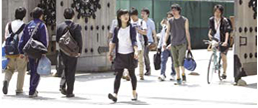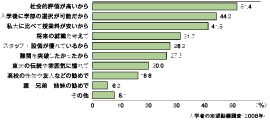Overview of the Junior Division
First and second years at the University of Tokyo study at the College of Arts and Sciences at the Komaba campus. During these two years at the Junior Division, students are given a broad liberal arts education.
In 1949, Tadao Yanaihara, the first Dean of the College of Arts and Sciences and later the 16th President of the University, is said to have made the following comment upon the foundation of the College.
‘The College of Arts and Sciences encompasses half of all students at the University of Tokyo. Yet its importance within the wider University lies not only in its size. For a period of two years the students study here and become baptised in the new ethos of higher education. The College is not a preparatory school for the university, but a constituent of it; a constituent moreover of paramount importance, giving students a solid base in general education needed for further specialised study, as well as a balanced intellectual foundation, and an ever-continuing thirst for knowledge. This is the spirit that forms the core of the College of Arts and Sciences.’
Today, more than 60 years on, such is still the philosophy that lies at the heart of education at the University of Tokyo. If you were to ever pick up The Charter of the University of Tokyo, you would find that the University sets the following as its goal: ‘The University of Tokyo will open its doors to all those with the suitable aptitude for learning and intellectual perspective. It will nurture future leaders in every field, who possess an international and pioneering spirit as well as specialist expertise, perception, insight, problem-solving skills, and imagination.’ The university thus places particular importance on the Junior Division education at the College of Arts and Sciences at the Komaba Campus, as a place to build an integrated and comprehensive base that will underpin subsequent specialist study. This fundamental educational policy of the university is known as ‘Late Specialisation’.
Higher education is changing along with society. The University of Tokyo continues to strive to adapt the teaching at the Junior Division at the College of Arts and Sciences, such that it remains relevant to the dynamic movements of contemporary society. For example, in 2005 we introduced the ‘Global Focus on Knowledge’ lectures in which cutting-edge researchers teach first and second years academic disciplines of different fields of study and the structure of ‘knowledge’ . In 2006, we also launched a new curriculum that is geared for students who have received secondary education under the government’s new study guidelines. Moreover, in 2008 we established the ALESS (Active Learning of English for Science Students) programme, a small-group course in academic English writing that aims to give students the communication skills needed to work as international practitioners in various fields of science and technology.
 In addition to introducing a new curriculum, we have also sought to create a rich environment that is conducive to learning. In 2006, we opened the Komaba Communications Plaza equipped with facilities for various extra-curricular activities, as well as a new classroom designed specifically for the performing arts and music, both of which have contributed to a great change in the atmosphere of the campus. 2011 also saw the launch of 21 KOMCEE, which houses studio classrooms designed to facilitate interactive learning based on ICT (Information and Communication Technology).
In addition to introducing a new curriculum, we have also sought to create a rich environment that is conducive to learning. In 2006, we opened the Komaba Communications Plaza equipped with facilities for various extra-curricular activities, as well as a new classroom designed specifically for the performing arts and music, both of which have contributed to a great change in the atmosphere of the campus. 2011 also saw the launch of 21 KOMCEE, which houses studio classrooms designed to facilitate interactive learning based on ICT (Information and Communication Technology).
The characteristics of learning:
acquiring fundamental ‘transferable skills’ applicable in any field
 In the Junior Division, we run compulsory courses known as Foundation Courses, which aim to ground students with the critical perception and intellectual mindset that will form the basis for any subsequent specialist field of study. Through classes in foreign languages, information sciences and physical education, both arts and science students will have the opportunity to develop their ability to understand and learn from other cultures, and refine their sense of judgement and ability to take action, all of which are increasingly needed in a globalising society.
In the Junior Division, we run compulsory courses known as Foundation Courses, which aim to ground students with the critical perception and intellectual mindset that will form the basis for any subsequent specialist field of study. Through classes in foreign languages, information sciences and physical education, both arts and science students will have the opportunity to develop their ability to understand and learn from other cultures, and refine their sense of judgement and ability to take action, all of which are increasingly needed in a globalising society.
In addition to these classes, arts students also study the paradigms and methodologies that underlie the modern humanities and social sciences, whilst science students are given the chance to obtain a broad foundation across the mathematical, material and biological sciences.
A comprehensive support system for a fulfilling campus life
 There are approximately 6,700 first and second year students at the College of Arts and Sciences, taught by 400 teaching staff (figures as of May 2011). The teacher to student ratio, one measure of the quality of teaching, is thus below 1:20, which is low even among universities across the world. Many classes are also supplemented by graduate students, who work as Teaching Assistants (TAs).
There are approximately 6,700 first and second year students at the College of Arts and Sciences, taught by 400 teaching staff (figures as of May 2011). The teacher to student ratio, one measure of the quality of teaching, is thus below 1:20, which is low even among universities across the world. Many classes are also supplemented by graduate students, who work as Teaching Assistants (TAs).
As well as in the classroom, the College of Arts and Sciences has established institutions such as the Student Counselling Center and the Academic Guidance Center, which allow thorough support for every student. Other forms of support include symposiums, which act as a platform for careers advice as well as for discussing concerns on both academic and day-to-day matters, and a special induction programme at the start of the year for new students.
Obtaining a comprehensive understanding through interdisciplinary learning
 One of the major aims of a liberal arts education is to gain an understanding of both the breadth and depth of academia from a macroscopic perspective, and an integrated and flexible comprehension that is not limited to specific disciplinary fields. We thus offer 400 to 500 lectures every semester under six streams of Integrated Courses: Thought and Arts, International and Area Studies, Society and Institutions, Human Beings and the Environment, Matter and Life, and Mathematical and Information Sciences.
One of the major aims of a liberal arts education is to gain an understanding of both the breadth and depth of academia from a macroscopic perspective, and an integrated and flexible comprehension that is not limited to specific disciplinary fields. We thus offer 400 to 500 lectures every semester under six streams of Integrated Courses: Thought and Arts, International and Area Studies, Society and Institutions, Human Beings and the Environment, Matter and Life, and Mathematical and Information Sciences.
Separate from these, we provide many other opportunities for learning through ‘Thematic Courses’, including lectures that probe deeply into societal issues and interdisciplinary themes from a multifaceted viewpoint, as well as small-group interactive classes. Thematic Courses can be chosen by students at freedom, and consist of Lecture Series, Seminars and Fieldwork. Being based on the students’ own enthusiasm and critical thinking, such seminars have the highest rates of student satisfaction among all of our courses.
Changing the style of learning through 21 KOMCEE
 For students entering the University of Tokyo, the first two years spent at the College of Arts and Sciences is a transition period from simply ‘studying’ to the academic pursuit of ‘scholarship’. It is a time that is not only important for deciding future directions and specialist fields, but also for establishing your own style of learning. This is a process that is fully supported by the Komaba Campus.
For students entering the University of Tokyo, the first two years spent at the College of Arts and Sciences is a transition period from simply ‘studying’ to the academic pursuit of ‘scholarship’. It is a time that is not only important for deciding future directions and specialist fields, but also for establishing your own style of learning. This is a process that is fully supported by the Komaba Campus.
The 21 KOMCEE, completed in 2011, offers an environment for active and participatory learning. This new teaching block is equipped with studio classrooms that are suitable for debate, presentation, group work, and practical learning. It also has lecture halls, a cafeteria, and open spaces that encourage interaction between students and staff. The building itself is also a state-of-the-art Zero-Energy Building (ZEB) equipped with an air conditioning system that utilises groundwater and an autonomous energy control system.
Two years for a careful consideration of future directions
The University of Tokyo admits students into one of three streams in each of the sciences and the arts. After two years of Junior Division study, students then progress to one of more than 50 Senior Division courses across 10 departments, depending on suitability and individual choice.
This system of admission to the Senior Division following two years of prior study and personal growth, is a major feature of education at our university, and is built on the principle of ‘Late Specializaion’. We have found it is a system that also has widespread support of the students; many students give the nature of the system as their main reason for applying to our university.
